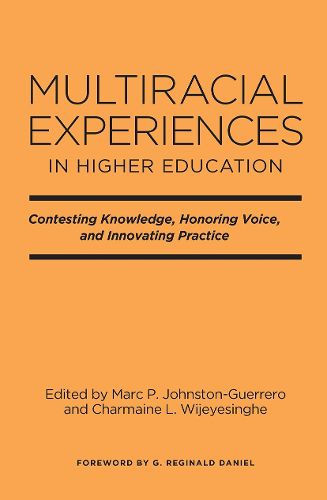Readings Newsletter
Become a Readings Member to make your shopping experience even easier.
Sign in or sign up for free!
You’re not far away from qualifying for FREE standard shipping within Australia
You’ve qualified for FREE standard shipping within Australia
The cart is loading…






This book centers the experiences of Multiracial people, those individuals claiming heritage and membership in two or more (mono)racial groups and/or identifies with a Multiracial term. These terms include the broader biracial, multiethnic, and mixed, or more specific terms like Blasian and Mexipino.
In addressing the recurring experiences of inclusion, exclusion, affirmation, and challenges that they encounter, the contributors identify the multiple sites in higher education that affect personal perceptions of self, belonging, rejection, and resilience; describe strategies they utilized to support themselves or other Multiracial people at their institutions; and to advocate for greater awareness of Multiracial issues and a commitment to institutional change.
In covering an array of Multiracial experiences, the book brings together a range of voices, social identities (including race), ages, perspectives, and approaches. The chapter authors present a multiplicity of views because, as the book exemplifies, multiracial people are not a monolithic group, nor are their issues and needs universal to all.
The book opens by outlining the literature and theoretical frameworks that provide context and foundations for the chapters that follow. It then presents a range of first person narratives - reflecting the experiences of students, faculty, and staff - that highlight navigating to and through higher education from diverse standpoints and positionalities. The final section offers multiple strategies and applied methods that can be used to enhance Multiracial inclusion through research, curriculum, and practice. The editors conclude with recommendations for future scholarship and practice.
This book invites Multiracial readers, their allies, and those people who interact with and influence the daily lives of Multiracial people to explore issues of identity and self-care, build coalitions on campus, and advocate for change. For administrators, student affairs personnel, and anyone concerned with diversity on campus, it opens a window on a growing population with whom they may be unfamiliar, mis-categorize, or overlook, and on the need to change systems and structures to address their full inclusion and unveil their full impact.
$9.00 standard shipping within Australia
FREE standard shipping within Australia for orders over $100.00
Express & International shipping calculated at checkout
This book centers the experiences of Multiracial people, those individuals claiming heritage and membership in two or more (mono)racial groups and/or identifies with a Multiracial term. These terms include the broader biracial, multiethnic, and mixed, or more specific terms like Blasian and Mexipino.
In addressing the recurring experiences of inclusion, exclusion, affirmation, and challenges that they encounter, the contributors identify the multiple sites in higher education that affect personal perceptions of self, belonging, rejection, and resilience; describe strategies they utilized to support themselves or other Multiracial people at their institutions; and to advocate for greater awareness of Multiracial issues and a commitment to institutional change.
In covering an array of Multiracial experiences, the book brings together a range of voices, social identities (including race), ages, perspectives, and approaches. The chapter authors present a multiplicity of views because, as the book exemplifies, multiracial people are not a monolithic group, nor are their issues and needs universal to all.
The book opens by outlining the literature and theoretical frameworks that provide context and foundations for the chapters that follow. It then presents a range of first person narratives - reflecting the experiences of students, faculty, and staff - that highlight navigating to and through higher education from diverse standpoints and positionalities. The final section offers multiple strategies and applied methods that can be used to enhance Multiracial inclusion through research, curriculum, and practice. The editors conclude with recommendations for future scholarship and practice.
This book invites Multiracial readers, their allies, and those people who interact with and influence the daily lives of Multiracial people to explore issues of identity and self-care, build coalitions on campus, and advocate for change. For administrators, student affairs personnel, and anyone concerned with diversity on campus, it opens a window on a growing population with whom they may be unfamiliar, mis-categorize, or overlook, and on the need to change systems and structures to address their full inclusion and unveil their full impact.